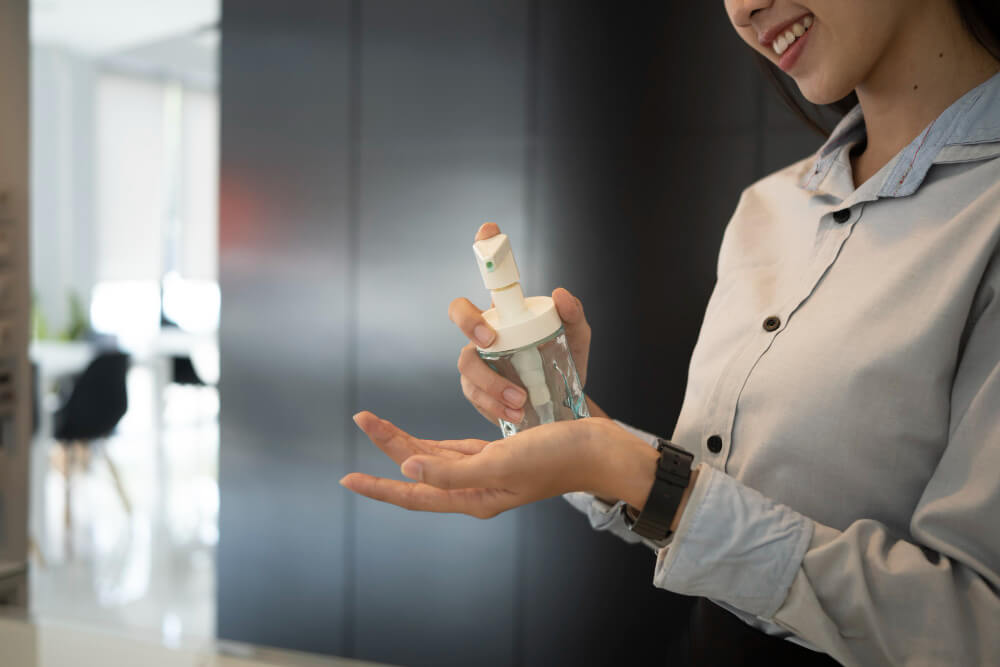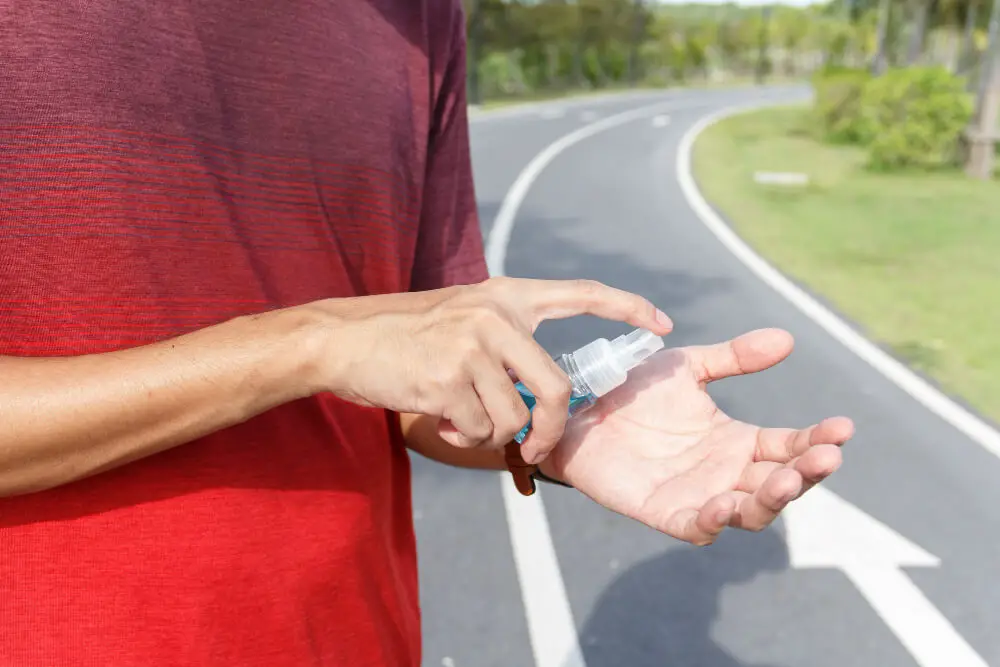Last Updated on August 8, 2023 By Emma W. Thomas
The correct order for cleaning and sanitizing is:
- Pre-rinse: Remove visible debris.
- Clean: Use soap and water for thorough cleaning.
- Rinse: Remove soap residue.
- Sanitize: Apply a sanitizing solution or disinfectant.
- Air dry: Allow surfaces to dry for effective sanitization.
Correct Order To Follow Cleaning And Sanitizing Utensils

Without further delay, let’s jump into discussing the correct order to follow cleaning and sanitizing utensils with the use of hands.
1. Uncomplicate The Utensil:
This step is the very first and one of the most critical aspects while cleaning. Some utensils seem complicated to use and wash at the very first glance. This utensil mainly carries multi-functionality, the sole reason behind its complicated structure or overall look. Most of these utensils feature additional blades, detachable parts, screens, and parallel other add-ons. These utensils provoke great utility in terms of usage but can give you a hard time when it comes to getting them cleaned.
So, what you have to do is detach it. However, be gentle and cautious while inaugurating the activity; it might leave you with a nasty wound or even get the utensil damaged. Most of these utensil types come with ‘How to detach? Or How to wash?’ guidelines. Follow the guide to get it done immaculately. All its add-ons are washable by nature; hence, place them on the sink separately and turn on the running water.
2. Rinse It Wholeheartedly:
Now that you have placed each part separately and got the running water on, the process that follows next is mere child’s play. To get the process running at a smoother rate, use the running water force to rinse off those stubborn oils and unnecessary leftovers. Be cautious enough to dump the useless left lovers from the sink into the wastebasket; it might clog the sink’s water passage. Once it’s done, move on to the next procedure. Use your hands to get the cleaning procedure done.

When you use your hands, the leftovers get removed effortlessly. If you feel uncomfortable doing so, you always use a piece of cloth or a scrubber to get it done. In today’s market, multiple scrubbing gloves are also available. These gloves improve the rinsing-off procedure pretty impressively. Another beneficial factor is, with this glove type, the rinsing-off approach also gets done within half the time that would have been required initially. When the rinse-off process gets done attentively, leaving behind no unnecessary residue, the step that follows next gets more comfortable to perform.
3. Clean It Thoroughly:
Moving on, use a dish soap liquid or bar soap. Well, that’s not all; help yourself by getting handy with an easy-to-use scrubber. Make sure this is not the same scrubber that you used when performing the previous step. What follows next is, dip it inside those washable fluids or bar soap and dab it on the utensils. With the collaboration of circular movements, get handy with the best possible cleaning that you can perform. Why is the circular movement way of cleaning considered to be the most effective way? Each area gets covered pretty well, and this way of movement amplifies the cleaning procedure’s effectiveness. Once done, rinse it off well. You rinse it off under running water or additionally use your hands as well. The choice is yours.
Many affordable dish soap liquids and bar soaps are readily available in the market these days. Multiple scented products under this same category are available as well. Some of the common ones are lime and rose. However, a good ratio of the population does not enjoy using artificially scented utensil cleaners or chemical compositions of the same format. The appropriate remedy for them is to use baking soda. Yes, you read that right. Baking soda is a natural cleaner and a superior option in comparison to liquid or bar utensil cleaners. Baking soda offers two benefits. First, it helps break down the stains quite quickly, and second, it can naturally reduce or eliminate any smell that lingers on the utensils henceforth.
4. Rinse Again:
It’s not a bubble bath, so you would not want to keep your utensils swamped up in the form of the utensils washer, would you? Well, rinse it off again. Running tap water that features some amount of reasonable force can get the job done more smoothly and saves a hell of a lot of time and effort at the same time. Rinsing is the icing that helps augment the step that follows next. Rinsing off well is essential, and it should be done regularly and with a lot of vigilance.
When you rinse off the utensils well, you get nothing but clean utensils as a reward. These utensils are additionally devoid of all the chemicals that held the composition of the dish soap wash. The baking soda residues also get washed off correctly. What is left behind is a shiny, clean, and fresh-smelling rack of utensils, waiting to get sanitized.
5. Sanitize It:
This pandemic season has made this one of the most crucial procedures to undertake. Sanitizing is undoubtedly essential and should have become a good habit of yours by this time. Hand sanitizing is substantial, and parallelly sanitizing your utensils is additionally crucial. When you sanitize your knives, you put an end to all the little bacteria. Sanitizing kills all these bacteria and gives you a clean and hygienic set of utensils to eat during the next mealtime.
How would you sanitize it? Well, there exist two different procedures to it. If you are a fan of all-natural methods, get handy with a simple and big container of hot water heated at a minimum of 171° F. Leave your utensils submerged there for some time to attain the optimum level of sanitizing. If you want, you can add an iota of salt as well. This sanitizing process can be time-consuming but exclusively fits your pocket pinch. The other method is to avail of a sanitizing fluid from the market. Use this chemical solution to sanitize your utensils efficiently.

Whether To Use Hands While Sanitizing Your Utensils With Your Hands Or Not?
| Use Of Hands | Use Of A Scrubber |
| Is associated with mindfulness and can lower your stress level. | Does not give way to any form of mindfulness or reduces stress. |
| Does not lead to the formation of any kind of allergy. | Can cause the formation of different types of allergies. |
| Exclusively heightens your immune system. | Does not do the same. |
| This procedure leads to minimum utilization of water. | Requires a good amount of water to optimize the cleaning process. |
| It is very delicate on the surface of the utensils. | Comparatively less delicate on the surface of the utensils. |
Everyone out there should follow this simple ritual to maintain good hygiene and stay healthy at the same time. It is a five-step procedure- detach (optional), rinse, clean, rinse again, and sanitize. If you are a regular meat eater, then you should sanitize your utensils more frequently. And, yes, always naturally air dry your utensils to optimize the effect of these five steps to the right health procedure.
Cleaning and Sanitizing Kitchen Utensils Made of Plastic and Enamelware
Proper care and maintenance of kitchen utensils are not only essential for prolonging their lifespan, but also for ensuring food safety. This article provides a comprehensive listicle on how to effectively clean and sanitize kitchen utensils made of plastic and enamelware.
1. Gather Essential Supplies:
Before starting the cleaning process, gather washing essentials such as dish soap, vinegar, baking soda, a scrubbing brush, a soft cloth, and water.
2. Washing Plastic Utensils:
• Pre-Rinse: Rinse plastic utensils under warm running water to remove leftover food particles.
• Scrub: Use a soft scrubbing brush and mild dish soap to scrub the utensils. Avoid using abrasive cleaners that may scratch the surface.
• Rinse: Rinse again under warm water to remove the soap.
• Dry: Allow the utensils to air-dry or use a clean towel to dry them off to avoid bacterial growth.
3. Deep Cleaning Plastic Utensils:
For stubborn stains, a deeper cleaning process is necessary.
• Soak in Vinegar Solution: Soak the stained utensils in a mix of vinegar and warm water (1:1) for 20–30 minutes.
• Scrub: Use a scrubbing brush to gently scrub away the stains.
• Rinse and Dry: Rinse under warm water and dry thoroughly.
4. Sanitizing Plastic Utensils:
• Sanitizing Solution: Sanitize the utensils by soaking them in a solution of 1 tablespoon of bleach to 1 gallon of water for about a minute.
• Rinse and Dry: Rinse under hot water and allow them to air-dry.
5. Cleaning Enamelware Utensils:
• Rinse: Rinse off food particles with warm water.
• Prepare Cleaning Solution: Prepare a cleaning solution by mixing dish soap with warm water.
• Wash: Use a soft cloth or sponge to wash the surface of the utensils, avoiding using steel wool or abrasive brushes that can damage the enamel coat.
• Rinse and Dry: Rinse thoroughly with warm water and dry promptly.
6. Handling Stained Enamelware Utensils:
• Create a Cleaning Paste: Mix a few tablespoons of baking soda with water to make a paste.
• Apply Paste and Soak: Apply the paste on stained areas and leave it for 15–20 minutes.
• Scrub and Rinse: Gently scrub the stained areas then rinse and dry the utensils.
7. Sanitizing Enamelware Utensils:
• Boiling Method: Place the utensils in a pot of boiling water for a few minutes.
• Air-Dry: Allow the utensils to air-dry.
In all cases, ensure that your kitchen utensils are regularly cleaned and sanitized for safe food handling. Always check the manufacturer’s instructions before attempting to clean these utensils to avoid damaging the utensil’s surface.
What is the acceptable way of sanitizing items in water?
There are a variety of ways one can sanitize items in water. One way is to clean them with soap and water, then rinse them off with hot water which will kill most bacteria. Another way is to boil the items for at least 1 minute, then allow them to cool before using.
When should you clean and sanitize surfaces?
You can clean most bacteria by wiping with soap and water, but some forms of it are resistant to this type of cleaning. There is also fecal coliform bacteria that you can’t see with the naked eye! That’s why it’s important to use disinfectant every time you clean these surfaces.
What are the methods of cleaning equipment?
Methods of cleaning equipment are important for restaurant owners to know in order to keep their business running smoothly and to protect the food they serve. There are three main methods for cleaning equipment: disinfection, decontamination, and sanitation. Disinfectants kill or stop disease-causing organisms from reproducing on contaminated surfaces.
When should you clean and sanitize surfaces?
This can mean a variety of different things, depending on what you are trying to disinfect. Disinfection is the process of killing bacteria and other organisms that cause disease by applying substances such as chlorine bleach or alcohol. It is important to clean surfaces with a disinfectant between patients to prevent the spread of germs from room to room.
References:
https://blog.martinbros.com/4-steps-to-cleaning-sanitizing-tables
https://www.lovetoknow.com/home/cleaning/correct-steps-cleaning-sanitizing-utensils-by-hand
Emma is a graduate of Domestic Science or Family and Consumer Sciences (Home Economics) from the University of Wisconsin. She has 7 years of experience Working with the strategic section of BestBuy and now writing full-time for Homeeon.
From Managing the Home, Interiors, Cleaning, and Exteriors to Gardening and everything about Making A Home Liveable – is her passion and this Homeeon is the result of this.
Emma loves decorating her home with the best stuff found online. She cares about quality over anything and writes reviews about them here in Homeeon. Get in touch with her over Pinterest.
Keep reading her blogs.

